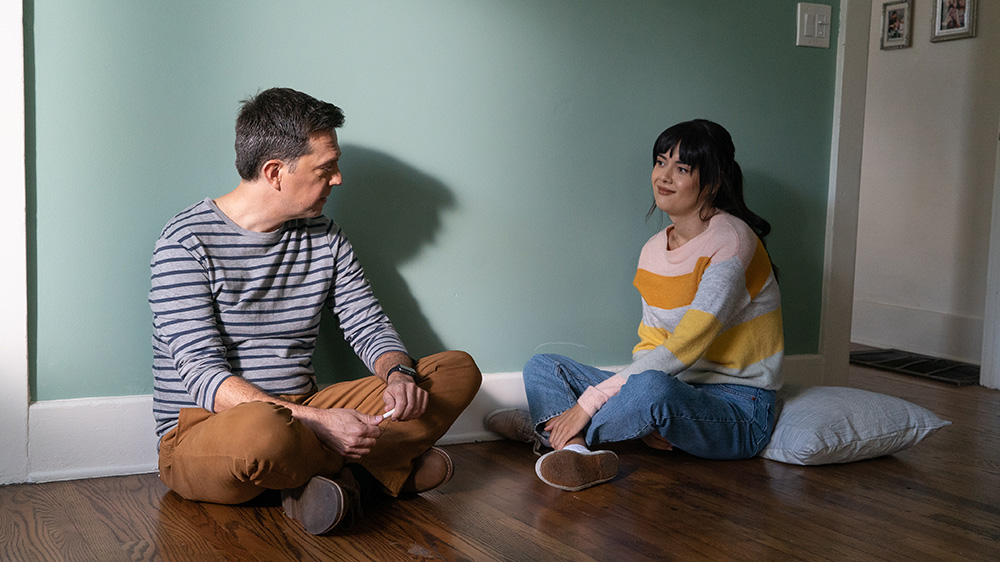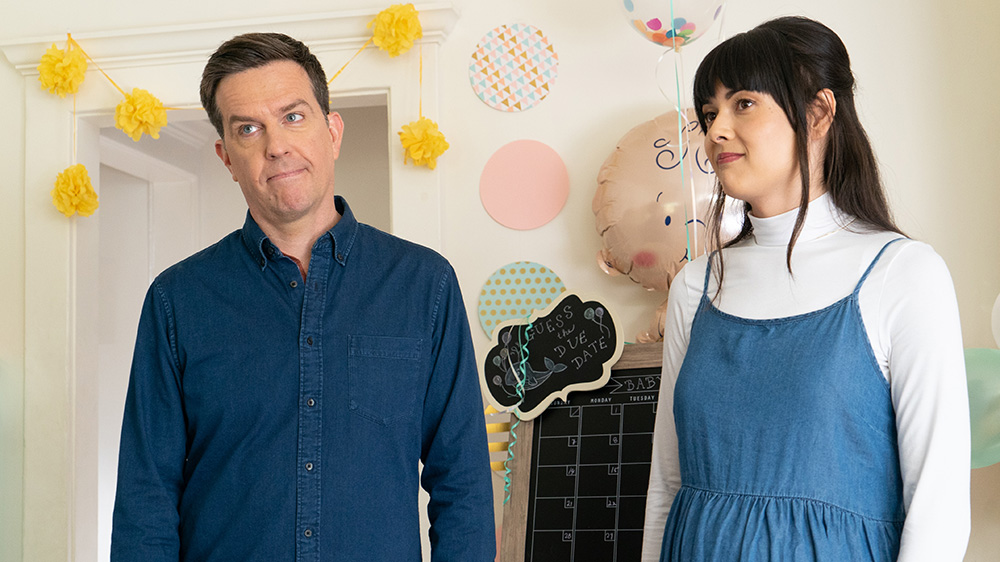I’m nervous too.
It’s not until a conversation about two-thirds of the way through that dissects how problematic the romantic relationships in Woody Allen movies are that I realized writer/director Nikole Beckwith was utilizing the infamous auteur’s signature font Windsor Light Condensed for her title card and chapter interstitials. I should have, though, considering how iconic a typeface it is in the context of cinema and just how impactful Beckwith’s film Together Together is at dismantling the stereotypes inherent to the romantic comedy dichotomy so many male filmmakers inject into their work—whether intentionally or not—to create fantasies of falling in love with a woman half their age. Because while Matt (Ed Helms) and Anna (Patti Harrison) do fall in love, sexual desire never plays a role in their bond.
That’s what’s great about the dynamic between these two characters: we aren’t wondering about the “Will they?” or “Won’t they?” questions. Beckwith does a wonderful job ensuring that we see them as the comfortable loners they are—connected solely by the common goal that is making Matt a dad. We therefore start with the interview process wherein Anna awkwardly earns the role of surrogate and continue through the equally awkward exchanges the two have as they traverse that journey together as two independent pieces of a single whole. He’s doing this alone to satisfy his biological clock’s need to become a father despite life leaving him single and without any prospects for marriage. And she’s taking on the responsibility without a support system of her own.

How then could they not inevitably find themselves leaning on each other? How could he not see Anna as something more than an incubator when her comfort and emotional happiness is at the forefront of his mind considering the baby she’s carrying has become his sole reason for living? And how could she not allow Matt to become an authentically invested figure in her pursuits to grow and succeed away from a volatile family life she must keep in her rearview lest fall prey to the feelings of failure they so expertly instill within her? These are narrative musts because they are human responses to a complex scenario both agree to for selfish reasons even though neither is a selfish person. A non-transactional connection proves unavoidable.
The work subsequently falls on Beckwith to engage with this truth in a natural way that retains its dramatic messiness without the allure of easy, trope-filled answers. As such, removing the potential for a May-December romance is but one necessity. She must also instill the mix of vulnerability and strength that allows Matt and Anna to risk the closeness with each other that they’ll need to survive what is generally drawn as a completely pragmatic partnership. That means stripping Anna of the clichéd struggle to want to keep the baby and the archaic notion that single men don’t have a desire to be fathers. Beckwith succeeding on both counts via plot is a victory unto itself. Her finding ways to comment and subvert through dialogue is a bonus.
Together Together‘s ultimate achievement is thus not to flip gender roles, but to erase them altogether. The film is normalizing the idea that a woman like Anna could bring a baby to term without a maternal attachment (beyond her excitement that Matt is able to live his dream) and the idea that a man like Matt can drown out the skepticism and consciously look to build a family on his own. These are human beings acting on human impulses while realizing that the concept of “doing it together” doesn’t demand conditional strings. Anna doesn’t need a father figure and Matt doesn’t need a wife. They simply need someone to remind them that what they’re doing is right simply because it’s the thing they want to do.

So why not take that mission to normalize a disruption of gendered assumptions further by casting a trans woman like Harrison in a cis woman role? And what better way to make your point than to not intentionally make it a bigger conversation than the film itself? This is a woman playing a woman. Period. No different than Helms being a man playing a man. As long as the bond they cultivate is honest, no one should be worrying about anything else. Do they fulfill their roles where the psychological impact of their actions is concerned? Yes. Do they confront each other’s outdated biases and listen in order to change their perceptions? Yes. This is a pragmatic relationship between a man and a woman told unpragmatically.
Don’t therefore be surprised when you find yourself investing in both of their lives independently from one another as much as this shared nine-month existence that could very well extend further if they’re able to look past the issues that society has preconceived as roadblocks to that possibility. It helps that each has his/her own supporting characters (Nora Dunn and Fred Melamed play Matt’s parents and Julio Torres plays Anna’s apathetic co-worker) to humorously flesh out their individual thoughts and ambitions en route to discovering they can actually provide that same support better by not having the baggage of history. Matt and Anna become each other’s most vocal champions and closest friends with a bond born from nothing but mutual respect. That’s a love that lasts.
photography:
[1-3] Ed Helms (left), Patti Harrison (right) Credit: Tiffany Roohani / Bleecker Street

